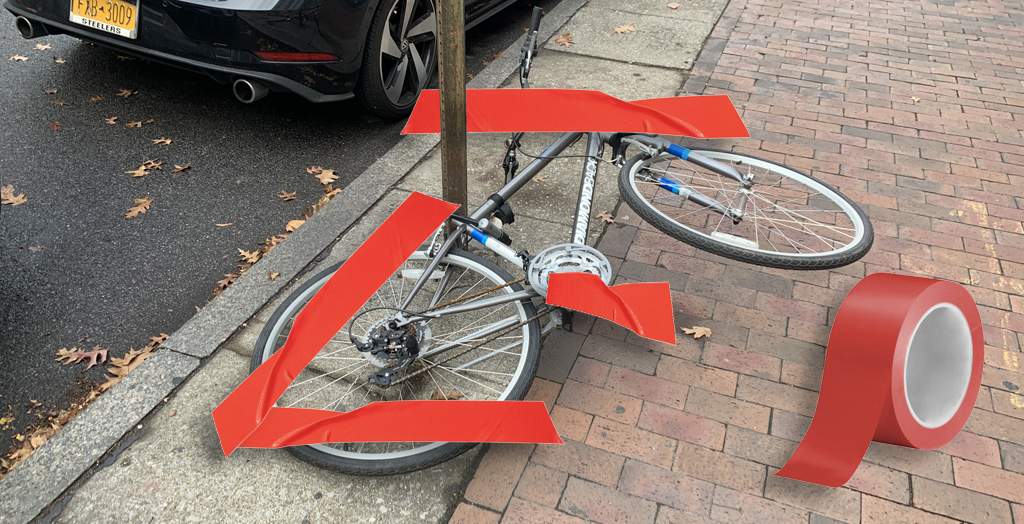As someone who bikes daily from Queens to Battery Park to give tours on Liberty and Ellis islands, I thought I’d seen every challenge New York could throw at a cyclist. I was wrong.
For two years, I’ve been parking my bike at the corner of Battery Place and Greenwich Street, after construction removed the bike racks in Battery Park. In all that time, no one has ever damaged or tampered with my bike — until this past Sept. 11, when the city Department of Transportation took my bike and forced me through an ugly labyrinthian bureaucratic maze to get it back.
Part I: The disappearing act
When I returned from my tour that afternoon, both my bike and the no-standing pole to which I’d locked it had vanished. Fortunately, some tour ticket vendors had witnessed what happened: the DOT had removed them both.
What followed was a masterclass in bureaucratic runaround that every cyclist should know about.
My first call to the city’s 311 service was met with flat denial — “The DOT would not do that.” The operator blamed construction workers, then suggested the police might have my bike at a local precinct. None of this was true, but it’s apparently what 311 operators are trained to say.
My wife found the online DOT Commissioner’s complaint line and filed a report. The next day, Sept. 12, DOT called back — not to help, but to tell us to file another complaint. After initially blaming construction workers and thieves, the DOT representative finally agreed to look up my bike. Sure enough, she found it at the Borough Engineer’s office under the 59th Street Bridge.
Part II: The retrieval mission
At the DOT facility on East 59th Street, a helpful maintenance worker confirmed that my experience wasn’t unusual. He showed me where bikes were stored and advised me to return Saturday morning at 8 a.m. with my key to prove ownership.
Saturday’s encounter with the sign department supervisor was eye-opening. He seemed genuinely angry that I had shown up, demanding to know who had sent me and questioning my identity. After checking his computer, he grudgingly admitted that his crew had indeed removed a stop sign with my bike attached on Sept. 11.
What happened next revealed the scope of this problem: the supervisor walked to a storage area and located my bike in less than a minute, suggesting they have many bikes stored there. The bike chain had been knocked off the sprockets, but the bike was otherwise undamaged.
Bizarrely, he then warned me that showing up at the facility was “highly unusual” and that he shouldn’t return because “we don’t know you and anyone can come in here.”
Part III: The truth comes out
A subordinate employee, more sympathetic to my situation, provided crucial insights during a brief conversation outside. He revealed that cyclists rarely come to claim their bikes — his section alone gets six to eight bikes weekly, and most are never claimed. More important, he explained that different DOT divisions handle bike removal differently, with various storage locations and procedures.
The bike rack division, he noted, is required to provide a seven-day notice before removing racks and any attached bikes. But his traffic sign division operates differently, with no advance notice given. The reason? Sign removals are often decided by traffic engineers working from home using Google Maps, not through on-site inspection.
Perhaps most troubling was his claim that DOT office policy prohibits chaining bikes to traffic signs, despite this not being accurate under city statutes.
On my ride home, I encountered another DOT crew removing a bus stop sign. When I asked how someone would recover a bike chained to such a pole, they understood immediately. They confirmed I was lucky my bike was taken in Manhattan, as different divisions store bikes at different locations —some with local precincts, others at various borough facilities.
Epilogue: What cyclists need to know — and what DOT needs to change
This experience revealed a troubling gap in city services. Here’s what every cyclist should know: If your bike disappears with a city pole or sign, do not believe initial denials that DOT wasn’t involved. Insist on speaking to someone with actual knowledge. Contact the DOT Commissioner’s complaint line directly.
If that all fails, you can find your borough’s DOT warehouse contact numbers on the DOT website.
But bigger issues need addressing. DOT divisions should coordinate better and provide consistent information. Advanced notice should be given before removing poles where bikes are commonly locked. Operators at 311 need accurate information about DOT bike removal procedures. Above all, the city should create a centralized system for tracking and reclaiming removed bikes.
The DOT employee who helped me suggested that many bikes go unclaimed due to misinformation and lack of knowledge about where to look. This represents both a waste of resources and a significant burden on working cyclists who depend on their bikes for transportation.
New York City has made great strides in supporting cycling infrastructure, but this hidden practice undermines those efforts. Cyclists shouldn’t need to be “lucky” to get their bikes back when the city removes them for legitimate infrastructure work.
The solution isn’t complicated: better communication, consistent procedures across DOT divisions, and advance notice when poles will be removed. Until these changes are made, cyclists need to know their rights and the procedures for bike recovery — because unfortunately, they might need them.
